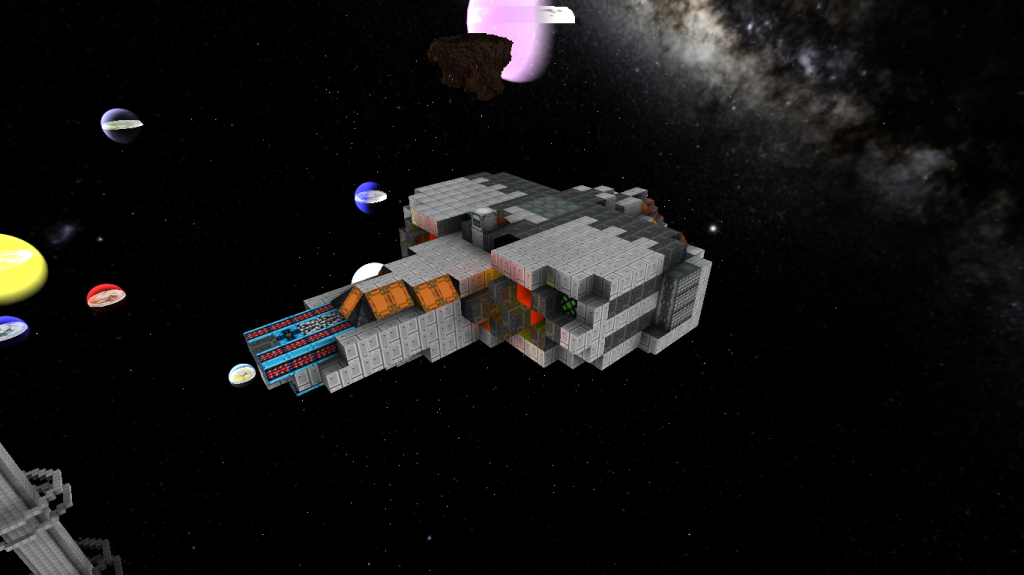The problem isn´t the server or crapy players computers pal, it´s the game engine.
"Lag" is several completely different things: server CPU load, networking bandwidth, and client graphics.
For server CPU load, a small number of huge things is lot better than huge number of small things. This is mostly because of collision detection (both for ships/turrets and for projectiles). E.g. with 3 huge objects there are 3*2=6 possible collisions that need to be tested, and with 1000 small objects there's 1000*999 = 999000 possible collisions that need to be tested (in other words, overhead grows exponentially with the number of objects, and doesn't grow linearly). There's also other factors (e.g. lots of bobby AI rather than a small amount of bobby AI).
For networking bandwidth, a small number of huge things is better than a huge number of small things. This is because each thing has meta-data (e.g. location, orientation, velocity, shield, etc). 2 huge ships might be a total of 20 million blocks (that don't change often and can be cached effectively by client) plus 2 lots of meta-data (that changes often and can't be cached well). 2000 small ships might be the same 20 million blocks (that don't change often and can be cached effectively by client) plus 2000 lots of meta-data (that changes often and can't be cached well, and flood the networking with a large number of "object meta-data updates"). Of course this includes projectiles (beams, missiles, etc) - e.g. a single massive turret that creates one very powerful projectile is better for network bandwidth than 1000 small ships/turrets that create 1000 weak projectiles.
For client graphics, it mostly depends on how many blocks and projectiles the game thinks might be visible (which is different to the number that actually are visible). For a huge solid ship it's easy for the game to figure out that most of the blocks can't be visible, and for many small ships this isn't the case; so (e.g.) "10 times as many ships that are 10% of the size" means a lot more graphics overhead (even though it's the same number of blocks).
Basically; for the same number of blocks, a smaller number of larger ships/turrets/projectiles is better than a larger number of smaller ships/turret/projectiles; for all of the different types of lag.
For different numbers of blocks, less blocks is better for lag (e.g. a single smaller ship is better than a single larger ship and a lot better than multiple smaller ships). This is why people think small ships are better for lag when they aren't - they're not doing a fair comparison, and are actually comparing "less resources" to "more resources" and finding that less resources is less lag.
Of course if you limit people to "less resources", then you can expect the majority of players to give a small amount of effort for their small reward, and then get bored and find a different game to play after a small amount of time.
If you want to limit lag but don't want to limit "reward for effort"; then the most sensible approach is to encourage players to spread their ("unlimited") reward over an unlimited number of sectors. For example, if a player or faction has 100 million blocks, then it'd be better for them to have 100 sectors where each sector has a 500 thousand block ship and a 500 thousand block station; rather than having a 100 million block ship/station in one sector, or having 1 million little (100 block) ships in one sector.
With all of this in mind; the solution to both gigantism and lag is to encourage people/factions to try to own the most territory. This could be done by (e.g.) having various resources in different areas of space, and making people need those resources. For example, one sector might have a gas giant (that the faction uses for cheap fuel), one sector might have a planet that's idea for growing "hamburger cows", one sector might have an asteroid field with a lot of one type of ore, another sector might have a planet that has a lot of another type of ore, etc. A faction/player might set up mining operations in each of these sectors to get a good supply of each of these resources (and have to defend their mining operations); and end up spreading their resources across many sectors. Of course people are greedy and/or cunning (e.g. a large faction might try to take control of every sector that has a gas giant, so that their enemies don't have a cheap source of fuel); so this could also add a lot of strategy to the game (where war is more than just a single"biggest faction wins" battle where the "winner" is the loser that lost the least; and where war becomes many battles for control of important resources).

